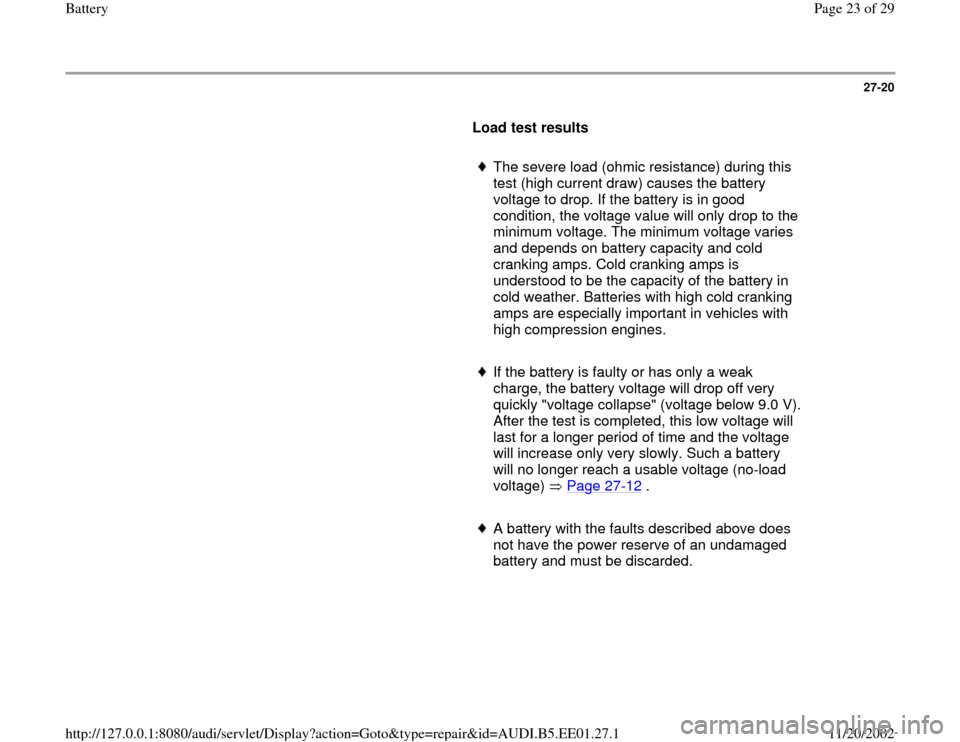Page 17 of 29
27-15
Use the following procedure to test the specific
gravity in all of the battery cells:
- Switch ignition off.
- Remove all cell caps.
The higher the specific gravity of the drawn electrolyte, the higher the
indicator will float.
The specific gravity of the electrolyte can be read in kg/dm3 on the
hydrometer scale. - Immerse tip of hydrometer into battery cell and draw out enough
electrolyte to allow indicator to float freely.
- Compare measured value indicated on hydrometer to values indicated
in table below:
Pa
ge 17 of 29 Batter
y
11/20/2002 htt
p://127.0.0.1:8080/audi/servlet/Dis
play?action=Goto&t
yp
e=re
pair&id=AUDI.B5.EE01.27.1
Page 18 of 29
27-16
State of charge in normal
climate zones Specific gravity in
kg/dm
3
Discharged 1.12
Half charged 1.20
Good charge 1.28
In normal climate zones, the specific gravity must
be at least 1.24 kg/dm
3.
- If specific gravity is too low: charge battery.
- After charging battery, repeat specific gravity
test.
Note:
The measured values for the specific gravity of
the individual battery cells must not vary by more
than 0.03 kg/dm
3.
Pa
ge 18 of 29 Batter
y
11/20/2002 htt
p://127.0.0.1:8080/audi/servlet/Dis
play?action=Goto&t
yp
e=re
pair&id=AUDI.B5.EE01.27.1
Page 19 of 29
27-17
Examples of unacceptable variations in
specific gravity:
Battery
cell: 1 2 3 4 5 6
Specific gravity per cell in kg/dm
3
Example
1: 1.24 1.25 1.25 1.10 1.24 1.25
Example
2: 1.26 1.26 1.25 1.14 1.18 1.24
Example 1:
The specific gravity in cell 4 is too low.
Example 2:
The specific gravity in cells 4 and 5 is too low
(the difference in specific gravity between the
cells is greater than 0.03 kg/dm
3).
- If values are not met, replace battery.
- If values are met, reinstall cell caps.
The original cell caps that came with the battery
must be reinstalled to help prevent leakage.
Pa
ge 19 of 29 Batter
y
11/20/2002 htt
p://127.0.0.1:8080/audi/servlet/Dis
play?action=Goto&t
yp
e=re
pair&id=AUDI.B5.EE01.27.1
Page 20 of 29
If the cell caps are lost or damaged, use
replacement cell caps of the same manufacture.
The cell caps must be equipped with an O-ring
seal.
Pa
ge 20 of 29 Batter
y
11/20/2002 htt
p://127.0.0.1:8080/audi/servlet/Dis
play?action=Goto&t
yp
e=re
pair&id=AUDI.B5.EE01.27.1
Page 21 of 29
27-18
Load testing
In order to better determine the overall
condition of a battery, always perform a load
test in conjunction with the specific gravity
test.
Special tools, test equipment and auxiliary
items
Note:
When using the VAS1979 or VAS5033 battery tester, it is not necessary
to remove the battery or disconnect the battery cables.
VAS1979 or VAS5033 battery tester
- Follow warnings and safety precautions for lead-acid batteries. Wear
protective clothing such as face shield and leather gloves.
Pa
ge 21 of 29 Batter
y
11/20/2002 htt
p://127.0.0.1:8080/audi/servlet/Dis
play?action=Goto&t
yp
e=re
pair&id=AUDI.B5.EE01.27.1
Page 22 of 29
27-19
Load test procedure
- Switch ignition off.
- Read battery tester operating instructions.
Battery tester operating instructions
Table - Observe carefully:
Connect the clamps to the battery terminals as required by the tester
instruction manual. The clamps must make good contact with the
battery terminals.
- Load current varies depending on battery capacity, set load current on
tester appropriately. - Obtain load current from table below.
The minimum voltage (the voltage which must be exceeded) varies
and can be obtained from the table below.
The load current and minimum voltage vary depending on the
capacity of the battery. Battery
capacity Cold cranking
amps Load
current Minimum voltage
(limit)
70 Ah 340 A 200 A 9.5 V
Pa
ge 22 of 29 Batter
y
11/20/2002 htt
p://127.0.0.1:8080/audi/servlet/Dis
play?action=Goto&t
yp
e=re
pair&id=AUDI.B5.EE01.27.1
Page 23 of 29

27-20
Load test results
The severe load (ohmic resistance) during this
test (high current draw) causes the battery
voltage to drop. If the battery is in good
condition, the voltage value will only drop to the
minimum voltage. The minimum voltage varies
and depends on battery capacity and cold
cranking amps. Cold cranking amps is
understood to be the capacity of the battery in
cold weather. Batteries with high cold cranking
amps are especially important in vehicles with
high compression engines.
If the battery is faulty or has only a weak
charge, the battery voltage will drop off very
quickly "voltage collapse" (voltage below 9.0 V).
After the test is completed, this low voltage will
last for a longer period of time and the voltage
will increase only very slowly. Such a battery
will no longer reach a usable voltage (no-load
voltage) Page 27
-12
.
A battery with the faults described above does
not have the power reserve of an undamaged
battery and must be discarded.
Pa
ge 23 of 29 Batter
y
11/20/2002 htt
p://127.0.0.1:8080/audi/servlet/Dis
play?action=Goto&t
yp
e=re
pair&id=AUDI.B5.EE01.27.1
Page 24 of 29
27-21
Battery, charging
CAUTION!
Battery cell caps must be screwed in tightly
when charging, measuring voltage or
performing load tests.
Do not enter the room in which batteries are
being charged with unenclosed light bulbs or
when smoking. The reason for this is that an
explosive gas is formed in the battery by the
charging process.
Special tools, test equipment and auxiliary
items
Battery charger
Batteries should be charged using a VAG
battery charger such as VAG1471, VAG1648 or
VAS1974.
Notes:
The temperature of the battery must not be less
than 10 C (50 F).
Batteries should not be fast-charged; fast-
Pa
ge 24 of 29 Batter
y
11/20/2002 htt
p://127.0.0.1:8080/audi/servlet/Dis
play?action=Goto&t
yp
e=re
pair&id=AUDI.B5.EE01.27.1